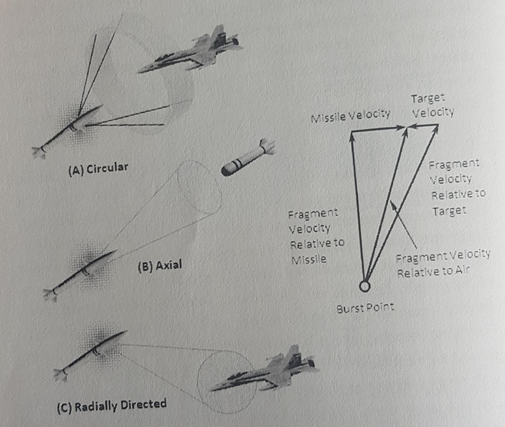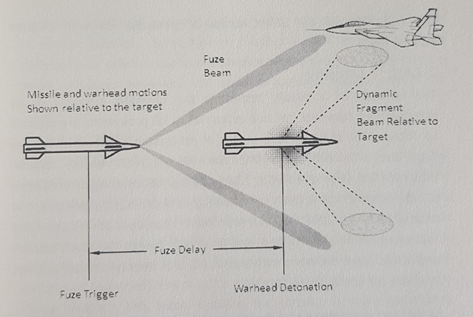Reading Activity
|
Warhead A bare high-explosive charge produces a high-pressure shock wave that radiates spherically from the burst point. The overpressure (pressure above ambient), the dynamic pressure (related to the air density and particle velocity behind the shock wave), and the time variation of these pressures interact with the target structure to cause damage. The relationship between the magnitude of blast damage and the radial distance from the burst point to the structural surface of the target depends on the weight and type of the high-explosive charge, the ambient atmospheric air density, and the design of the target structure. The ability of blast effects to cause target damage falls off sharply with increased range from the burst so sharply in fact that blast is not an effective damage mechanism unless the miss distance is very small or the high-explosive charge is very large. In terms of fragmentation pattern, the following three types of warheads are distinguished: warheads with circular patterns (Figure 9); warheads with axial patterns (Figure 9(B)); and warheads with radially directed patterns (Figure 9(C)). Circular pattern fragmentation warheads are most commonly used (Figure 9(A)). Their main advantages are the highest efficiency factor of explosive charge energy, arrangement of the warhead in any part of the missile, and engagement of targets at any side misses. |
 |
|
Fuze The fuze is the device that initiates the signal to detonate the warhead. Most surface-to-air missiles contain two fuzes—an impact fuze that is triggered by impact with the target and a proximity fuze that is triggered by a close approach to the target. Focusing the warhead energy into a narrow beam increases its radius of effectiveness (lethal radius), but it does so at the cost of increased sensitivity to the timing of the detonation. To be effective, a warhead must be detonated at a time when its expanding fragment beam will intercept a vulnerable part of the target. In a typical nose-on engagement the time during which a detonation will result in fragment impacts on the target is approximately 12 ms. The fuze must sense the approach to the target and initiate the firing signal so that detonation occurs within that period. Often the fuze beam is swept forward at 4a greater angle than that of the anticipated dynamic fragment beam, allowing a short delay time between fuze triggering and actual warhead detonation as illustrated in Figure 10. For a fixed fuze beam angle the optimum fuze delay varies considerably for different engagement velocities and aspect angles because of the variation in the angle of the dynamic fragment beam. Various schemes have been devised to estimate closing velocity as a basis for adaptively setting the fuze delay time (adapting to the situation in real time), but to reduce costs and complexity, often a delay time is selected that is a compromise among all anticipated engagement conditions. |
 |